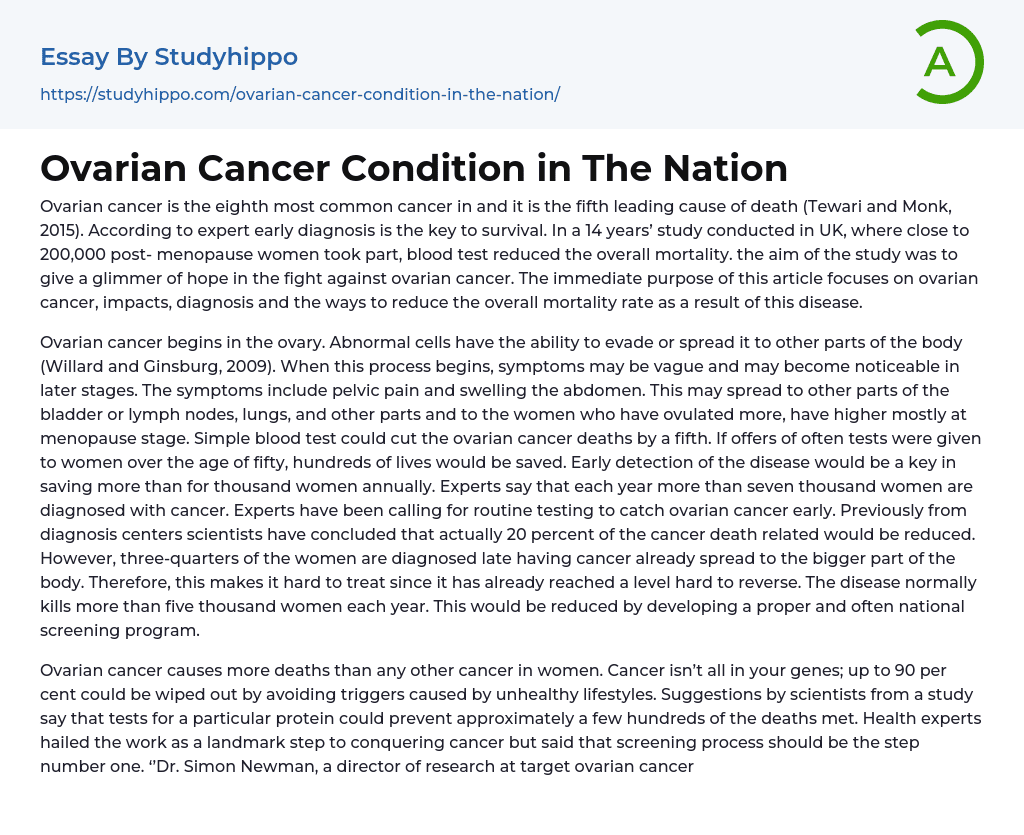According to Tewari and Monk (2015), ovarian cancer ranks as the eighth most prevalent cancer and the fifth highest cause of death. Experts emphasize that early detection is vital for survival. A study conducted in the UK spanning 14 years, involving approximately 200,000 post-menopausal women, revealed that blood tests lowered overall mortality rates. This discovery instills hope in the battle against ovarian cancer.
This article primarily discusses ovarian cancer, including its effects, diagnosis, and ways to decrease the overall mortality rate linked with the disease. Ovarian cancer begins in the ovary and can spread to other body parts via abnormal cells. Initially, symptoms may be unclear but become more evident over time. These symptoms comprise pelvic pain, swelling in the abdomen, and potential metastasis to the bladder, lymph nodes, lungs, and other regions. Women who have experienced menopause or have a higher frequency
...of ovulation face an increased risk.
Experts suggest that regularly administering blood tests to women aged fifty and above has the potential to reduce ovarian cancer deaths by 20%, ultimately saving hundreds of lives annually. Early detection is crucial in saving over a thousand women each year, given that more than seven thousand receive a cancer diagnosis annually.
Medical professionals are stressing the importance of regular testing for ovarian cancer as it can lead to early detection and potentially decrease cancer-related fatalities by 20%. Unfortunately, the majority of women receive a late diagnosis when the cancer is already advanced and irreversible. Consequently, treating this disease becomes quite difficult. At present, over five thousand women lose their lives to ovarian cancer each year. Implementing an effective and consistent national screening program could greatly reduce this number.
Ovarian
cancer is the leading cause of death in women with cancer, and it is believed that up to 90% of cases are caused by unhealthy lifestyles rather than genetics. Researchers propose that by testing for a specific protein, many deaths could be avoided. This research marks a significant advancement in the fight against cancer; nevertheless, healthcare experts emphasize the importance of starting screening as the primary preventive measure.
Simon Newman, a director of research at target ovarian cancer, stated that the results of this groundbreaking study, considered a major milestone in ovarian cancer research, place us in a stronger position to collectively improve earlier diagnosis and increase survival rates for women (Farghaly,2014). It is crucial to implement a screening program to prevent ovarian cancer-related deaths. These findings offer hope for campaigns against ovarian cancer and advance the nation's efforts in early detection. However, it is important to be mindful and realistic as the implementation of such a screening program could potentially require many years and be conducted in two different ways.
Ultrasound is one way of diagnosing ovarian cancer, which is performed annually. Another method involves a blood test for CA125, which has resulted in decreased mortality rates overall. It is possible that the reduction in mortality rates may be significantly higher or lower than initially estimated after further follow-up over a few more years. Detecting ovarian cancer through careful screening is crucial as it helps avoid false diagnoses after surgery. This emphasizes the need for extensive research to determine the actual decrease in deaths and whether widespread screening is cost-effective. Factors to consider include additional follow-up to assess the complete impact on mortality reduction and health
economic analysis (Tewari and Monk, 2015).
Improving ovarian cancer screening tests can enhance efforts to improve this process. Despite the clinical and resource implications, this method offers acceptable mortality benefits compared to other cancer diagnosis and screening programs. Therefore, this study represents a significant milestone in the search for effective screening methods for ovarian cancer, also known as the silent killer. Historically, progress in addressing this disease has been slow; however, implementing a screening method could help identify it at a treatable stage. Although further studies are needed for conclusive results, recent research indicates that progress is accelerating in this field.
Further investigation is necessary to determine the test's effectiveness in relation to ovarian cancer risk. Women concerned about their risk should consult their doctors for a more comprehensive explanation of their cancer risk and available screening tests. Private partners are also contributing to reducing cancer-related deaths by ensuring that the screening process is effective and adequately funded. Although national screening is still a long way off, raising public awareness of the different symptoms associated with ovarian cancer is crucial. This will result in earlier diagnosis and more individuals seeking assistance if they may be affected. Individuals who have already been diagnosed with cancer have also embraced these findings.
Physiotherapists and other experts emphasize the significance of early screening for ovarian cancer, giving hope to those who may have doubts about undergoing the screening process. Physiotherapists from different areas actively support and educate women and the public about lifestyle changes that can aid in preventing and managing the disease. This article offers insights into ovarian cancer, including its impacts, diagnosis, and effects, with the goal of safeguarding current
and future women from infections associated with ovarian cancer.
References
- In Farghaly, S. A. (2014). Advances in diagnosis and management of ovarian cancer.
- Tewari, K. S., & Monk, B. J. (2015). The 21st century handbook of clinical ovarian cancer.
- Willard, H. F., & Ginsburg, G.
S. (2009). Genomic and personalized medicine: Volume 1. Amsterdam: Elsevier.
- Addiction essays
- Anatomy and Physiology essays
- Biodegradation essays
- Cancer essays
- Dental Care essays
- Disability essays
- Disease essays
- Disorders essays
- Health Care essays
- Infectious Disease essays
- Inquiry essays
- Intelligence Quotient essays
- Lung Cancer essays
- Medicine essays
- Neurology essays
- Nutrition essays
- Olfaction essays
- Physical Exercise essays
- Public Health essays
- Sex essays
- Women's Health essays
- World health organization essays




